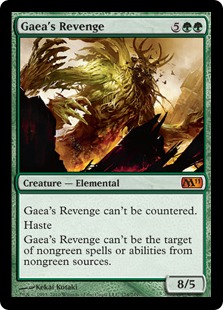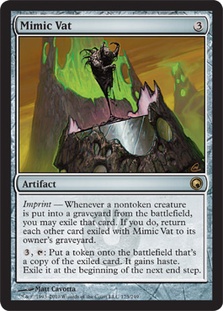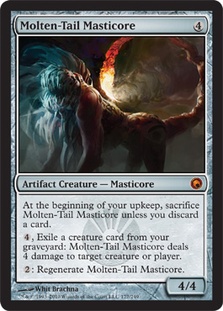Hello, everyone; welcome back to the circus of MTG finance. I promise not to show you how to install malware on your
computers this week. Instead, I’m going to talk about how to spot cards that are on the rise. There’s a new format since Shards of Alara has
rotated, and everyone is brewing, It’s times like these that there are a lot of opportunities to gain value if you can stay ahead of the game.
When I talk about a card that’s “on the rise” I don’t only mean pricewise. Sometimes when a card
becomes more desirable, the price goes up. This is almost always the case on Magic Online (MTGO), but in real life, there are many times that a card
will stay the same price despite an increase in demand. A good example of this is Malakir Bloodwitch last season; despite being in Vampires and
in the sideboard of Jund, the card was always a three-dollar card. As a trader/dealer, the question is: should you pick up a card that’s not
going up in price, but is in demand?
I know a lot of people who won’t pick cards like this. They say things like, “Yeah, I’m interested in the
Argentum Armor, but I’m not sure what it’s going to do pricewise.” This imaginary person is obviously concerned about using his/her resources
for maximum value; this is a good thing, but the key here is finding what’s useful.
I am going to steal a bit from my homeboy Patrick Chapin‘s book. In his book
Next Level Magic,
he talks about sharpening your mental game
by focusing on what matters or what is useful and not getting locked into a single route of victory. On page 37, this phase is boxed
for emphasis.
“Focus on what is useful.”
This is great advice for playing Magic. I can’t count the times that I’ve Brainstormed, either with Jace or
with the one mana instant, and caught myself sloppily keeping “good cards” rather than useful cards. My foolishness becomes evident when my
opponent casts a game-winning spell, and my Counterspell is sitting safely on top of my library while all my hand is cluttered with irrelevant spells.
Damnit, if I would’ve just focused on what was useful in the context of the game, I would’ve been able to counter that spell.
Momentum
The same is true about your trade binder. Imagine that every trade is a Brainstorm; you have the opportunity to take
cards that might be more useful than other cards. It’s always smart to trade for the cards that will be desirable, regardless of whether their
price is going up. This protects you from losing value to rotation price drops, and it keeps your binder relevant. Last season I traded off my Maelstrom
Pulses for Fauna Shamans. At the time the Pulses were worth more, but it had been a month since anyone asked for them. If I had clung to values, I
would’ve kept the Pulses until rotation and lost massive value. Not to mention, the opportunities that I would’ve lost by not getting the Fauna
Shamans. This concept is called momentum.
Momentum is the best way to both gain value and grow your trade binder. If you read my Pack to Power adventures, then
you’d see that I was constantly looking to get cards that were going to be the most interesting to my trade partners. This idea of momentum is pretty
simple; use the slow-moving cards or the cards that have a low level of interest to get cards that are “hot” or in-demand. When you think
about it, it’s pretty duh-tastic advice, but some people are so attached to value that they may miss key opportunities to gain momentum.
I’ll be bold and say this:
Momentum is more important than value.
Whoa! Isn’t this trading/selling cards thing all about value? It is, but this is my attempt to get you to think
more “big picture,” instead of helping you feed the urge to be shortsighted. There should be a hierarchy to the way that you conduct business; this
will define what’s most important to you when you make deals and trades. We as traders and small-time dealers have to configure our hierarchy differently
from big-time dealers like StarCityGames.com. The big dogs still have to have momentum, but not as much as we need; their stock is sitting on a
website for sale, and ours is sitting in a binder or in boxes. We can’t move stock as easily as they can, so momentum, not stock, is more
important. My hierarchy looks like this.
1) Community Health — I try to make deals that are good for the Magic community at large. This wasn’t always
the case, but I’ve done some maturing in the last few years, and this now takes the top priority in deals. You guys as a community have been so
good to me that I owe it to you to become an evangelist for the game, and since I’ve been teaching you all my secrets, it’s really hard to
get any value in trades anyway, so I may as well be moral.
2) Momentum — Momentum is the second most important thing to me. Because, I’m not looking to gain blunt value in
trades (see above). I have to make my money through creating opportunities and riding rising card prices.
3) Value — Trading for value simply means that you give less core value than you get. This is lower on my
hierarchy than momentum. This means that I’ll make a momentum trade even if I’m losing core value. This is the point that I started to make above; I’m
so glad that I made it back to it.
Momentum is more important than value.
I was saying that people miss key opportunities to gain momentum because they’re too attached to the value concept.
There are some opportunities to gain momentum that are counterintuitive but still can be correct. For example, if you have the opportunity to trade a
dual land for a stack of Wurmcoil Engines, you should consider it. I guarantee that more people will be willing and able to trade for the Wurmcoil Engines
than the dual land. This is especially true for Standard cards that have high price tags, like Primeval Titan for example; if you had a chance to
trade a Primeval Titan for a pile of Frost Titans, I’d recommend it.
In the past, I’ve taught you to be careful when trading down (trading an expensive card for multiple less expensive
cards). You should still consider the concepts of trading up and trading down, but now you have the measure the tradeoff between gaining momentum and
keeping stock. You have to ask yourself which is going to position you better. I’m not saying that you should gain momentum no matter what or at
any cost. I’m saying that momentum should be given more weight than value in the decision-making process. At the end of the day, only you can
truly make a decision about what the best trade is. Only you know how much you paid for what you’re trading, and you have outlets and mini-markets
that are specific to you; these factors are different for each person.
I knew a kid, who would come to my local store once a month and trade me staples for textless cards and foil promos. One
time I asked him, “What’s with the promos, man?” He told me that his store is very small and that they don’t get
many promos there; the community there trades really heavily for them. This is an example of momentum in a mini-market; though the staples are probably
better for trading to a general audience, this kid was focusing on what was useful to him.
Alright, that’s enough theory for today; let’s talk about the more practical side of this gig. Contrary to
popular belief, I don’t have Jedi skills that allow me to automatically know which cards are going to go up. I also don’t have a bat cave
with multiple computer monitors that track card trends (or do I?). Instead, there’s a system that I plug into which tells me which cards will
become more desirable and when. This network is a three-prong network, or as I like to call it, the Momentum Trinity: forums, Twitter, and MTGO. This
plays well with the hive mind concept that’s been floating around, and these aren’t the only three ways to get information, but I think they might be
the most relevant.
Forums
The scenario is pretty typical; someone posts about a card or a deck idea and then an army of trolls flames the person
for their obvious (but really
not so obvious) stupidity and over-all suckiness, but many times there’s new technology locked away in these forum posts. Here
is a
forum post
that I wrote before
Boros Bushwhacker was a deck. Did you notice the Ranger of Eos plus Goblin Bushwhacker technology? The deck was probably crap, but that piece of
technology was instrumental in the Boros deck and was also used in some Naya builds at the time. You should be scouting forums for technology and then watching
as the meta or decks have need for that technology. Here are some deck development forums to follow.
Star City
Games (Standard Decks)
MTG Salvation (Standard Deck Ideas)
The Mana Drain (Vintage Development)
MTG The Source (Legacy
Development)
If you’re not on Twitter, then you’re missing out on a metric-crap-ton of information. I’m of the opinion
that it’s a requirement for any serious trader or dealer to have and monitor a Twitter account. The best that I can do to help convince you of this
is to show you how Twitter has given me an edge over the last few weeks.
Frost Titan
I’ve been watching this card since it was printed. My instinct said that it was good because of the synergy with
Mana Leak, but at the time, it was hard to imagine a Titan-driven metagame like we have now. I think that’s why Frost Titan didn’t get any
props in the beginning.
I first noticed movement around Frost Titan in the R/U/G Titan list that was floating around pre-rotation. I put that
fact in my little fact jar and continued to watch the card. The next time that I saw it appear was post-rotation in the U/R list at the TCGPlayer.com
tournament in New York. I was interested in learning the list, so I watched the footage and saw how dominating the Titan was. I was almost ready to
pull the trigger and start buying them up when I saw this.
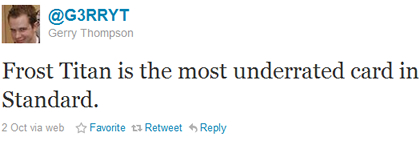
Then I did this:

Frost Titan went from three tickets to nine tickets! I bought out every bot and site that I could on MTGO, and I sold
out after stocking my bot.
Pyromancer Ascension
I dismissed this card when it was first printed, until I played against the first version of the deck. It was a Naya
build with a blue splash that used Naya Charm to get back Time Warp and Naya Charm and then bored you to death while your opponent pleasured himself by
shuffling his deck and drawing cards until he drew a Lightning Bolt. The card was on my radar ever since, and it has proven to be powerful in Standard
and in Extended (it was played at Pro Tour Amsterdam with Manamorphose). I think the card even has Legacy potential.
People were looking for the Michael Flores brew before States, but only a top-secret network of people got the list
before States. I’m not on the
Flores preferred list; I think you have to have, like, one million lifetime
Flores
Rewards
or be KYT from
Mana Deprived
to actually get on that list. I knew
that he had brewed up something awesome, so I was watching
his Twitter
feed and waiting to pounce on the new tech.
Then I saw this:
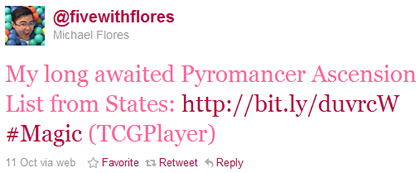
So, I said this:
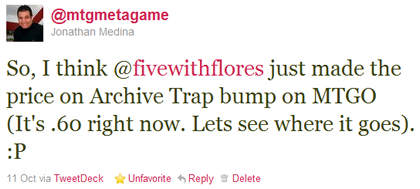
I was sure that even though Flores scrubbed out of States with the deck (I love you, Mike) that it was legit. (How can
it not be? Flores brewed it.) I bought all the Pyromancer Ascensions and Archive Traps that I could find on MTGO. Then Patrick Chapin reaffirmed my
decision to invest by saying this:
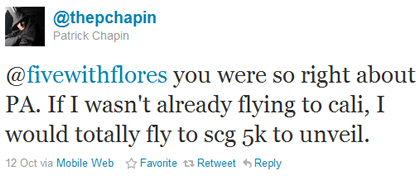
Archive Trap went up to 2.5 and so did Pyromancer Ascension (from .60 and .90 respectively) on MTGO. I dumped my
purchases into my bot and sold out again.
As you can see, Twitter lets you get on the inside track on the latest tech, even before articles are published or
tournaments are finished. I’ll leave you with one more tweet before I move on to a list of people that you should follow on Twitter. This tweet was
posted to me from Tom Martell after I had bought up the Archive Traps and Pyromancer Ascensions.
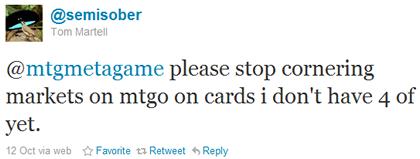
There are tons of people that you should follow on Twitter, so take some time to explore and add the people that you
like to hear from. Here’s a short list of the absolute bare minimum of people you should follow.
Jonathan Medina, that’s me!
@mtgmetagame
Patrick Chapin
@thepchapin
Michael Flores
@fivewithflores
Gerry Thompson
@g3rryt
StarCityGames.com Buyer
@starcitybuyer
Conley Woods
@conley81
Brian Kibler
@bmkibler
Tom Martell
@semisober
I’ll end up putting the whole Twitterverse on this list if I don’t stop, so I’ll just stop there. If
you have Twitter, add these people; if you don’t, then get it and add these people. It’ll make you privy to top-secret information.
MTGO
As you can see, I made use of MTGO above to profit on the information that I received via Twitter. MTGO can also be used
to spot price spikes on cards. If you see that bots are buying cards at higher prices than they were the day before, then you should ask yourself,
“Why?” Even someone who didn’t have Twitter could see from the classified section on MTGO that Pyromancer Ascension and Archive Traps were
moving in price.
The other thing about MTGO is that you can see the hive mind at work. Scars of Mirrodin is pre-releasing this week on
MTGO. So, next week (after the
official) release, you should start checking out the decklists from the
Daily
Events
to see what decks are winning. This will be helpful when you’re gathering information to make a decision whether to buy or not. Put that
information together with other information from Twitter and forums to get a full picture of where you can gain momentum.
I hope this article has helped you to understand momentum and given you some tools to spot cards that are picking up
speed. Here are some cards that I’m hearing murmurings about; watch these ones.
Cards to Watch
Gaea’s Revenge — Ramp decks are shaping the metagame, but control decks are starting to adapt and gain
favorable matchups. Frost Titan is a
great way of neutering ramp’s threats, and now these decks will have to adapt. If you watched
The Magic Show
last
week, you might’ve noticed that there were three of these guys in the sideboard of one of the winning decks that Evan talked about. Keep an
eye on this guy; he can’t be Frosted, and you can pick them up cheap at the moment.
Mimic Vat — Mono-Black has always been a beloved archetype. The reprinting of Nantuko Shade gave Mono-Black
players wet dreams for weeks, but as
the metagame unfolded, Mono-Black was found lacking, still missing a crucial piece of the puzzle. The
States results in Ohio
suggest that the
missing piece is Mimic Vat. I‘ve been mobbed for these cards, and even my suppliers are having trouble keeping them in stock.
Molten-Tail Masticore — At States I traded for about ten of these. I sold eight of them online and posted a tweet
about how quickly they moved. That’s when Brian Kibler said this:
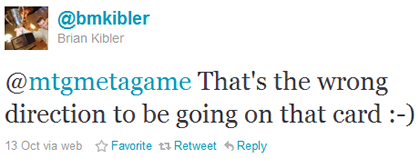
Do you think Kibler knows something I don’t? Of course he does! I’ve been seeing the Masticore in Mono-Red
lists and in Fauna Shaman lists. I’ve also lost to the card, and it’s a lot better than it’s getting credit for. I’d keep an eye on this one.
Thanks for reading. See you in the forums, for discussion.
Jonathan

